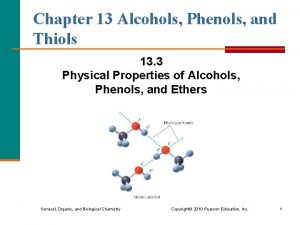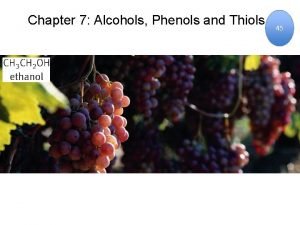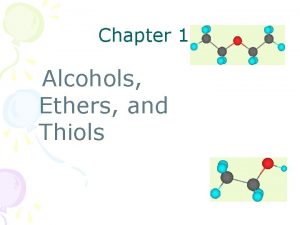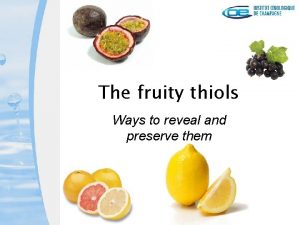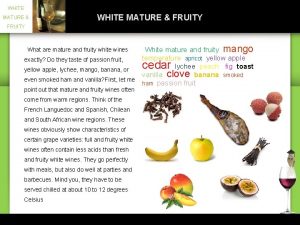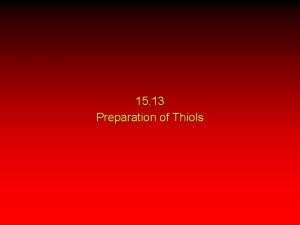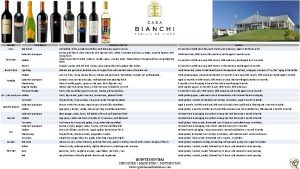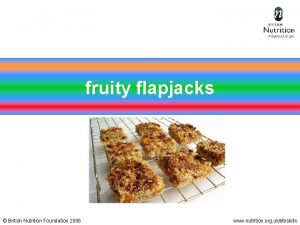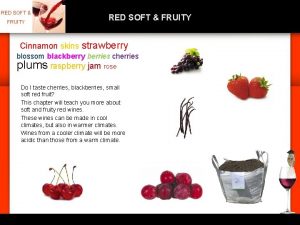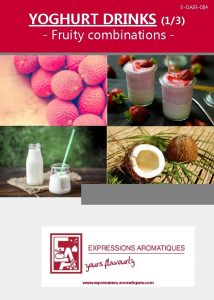The fruity thiols Ways to reveal and preserve





















- Slides: 21

The fruity thiols Ways to reveal and preserve them

THE THIOLS : MAIN TYPES • 3 -mercaptohexan-1 -ol (3 MH): citrus fruits and passion fruit • Acetate of 3 -MH (A 3 MH): flowers, passion fruit • 4 -mercapto-4 -methylpentan-2 -one (4 MMP): boxwood, broom

Characteristics and types of thiols • Highly perfumed (perception threshold of ng/L or x 10 ng/L) • Sensitive to oxidation • Aroma poorly developed from precursor, by yeast during fermentation • Present in numerous varieties: colombard, sauvignon blanc, pinot noir, gamay, shiraz, grenache…

SENSITIVITY OF THIOLS TO OXYGEN

Oxygen : all about time and quantity. Sensory Analysis (n=6) on 3 batches of the same wine with various doses of oxygen: differences appear after 3 months O 2 minimal O 2 ~2 mg/l Plant, citrus fruit, sulfur floral reduction fruity yeast O 2 ~5 mg/l jam cooked fruits madeira évent roasting butter lactic oxidation

Why is it detected too late ? Oxygen combines quickly with wine c. Content O 2 (mg/l) 10 8 6 19°C 4 13°C 4°C 2 Time (day) 0 0 2 4 6 8 10 And when measuring … nothing visible (this curve is not a reference) 12

Oxygen : Need to take action quickly! O 2 Phenols Catechins Acids Quinones

Oxygen : Need to take action quickly! QUINONES strong Reduction weak

A natural solution : GLu. Ta. Ro. M • Inactivate yeast rich in glutathion • 100% natural Origin • For a preventative and fast action

Natural solution: GLu. Ta. Ro. M White sauvignon wine enriched or not in glutathion during alcoholic fermentation and ageing on lees. Wine redox potential (m. V) 390 370 350 330 Without LIS enriched in glutathion 310 Volatile Thiols : impact of inactivated yeast enriched in glutathion With LIS enriched in glutathion 290 1000 270 900 250 800 0 1 2 3 [oxygen] (mg/L) 4 5 6 7 From INRA Montpellier, UMR « Sciences pour l’œnologie » 8 Without LIS enriched in GSH With LIS enriched in GSH 700 600 500 400 These results are confirmed on shiraz rosés and grenache 300 200 100 0 3 MH (ng/L) 3 MHA (ng/L) From INRA Montpellier, UMR « Sciences pour l’œnologie »

How to use GLu. Ta. Ro. M • Preventative Action : addition of GLUTAROM in must (yeast culture… or earlier) • End of Alcoholic Fermentation (AF) : step where wine is most vulnerable to oxygen addition of GLUTAROM possible and strongly recommended if AF failing • Really efficient on white, and rosés, especially for sensitive fruit (poor initial content of glutathion)

CONVERSION OF THIOL PRECURSORS TO FRUITY AROMA

Conversion of thiol precursors : the part of yeast • Strong concentration of precursors in several varieties… • … but poorly transform in aroma ! (often less than 1%) A moderate change in the conversion output can have important consequences in terms of concentrations in the wine Select the yeast with good output of conversion of precursors to thiols with fruity aromas

A new selection of yeast: IOC Revelation Thiols Results of different tests with IOC Revelation Thiols compared to classical yeasts used to obtain thiols • Over expression of 3 MH • Under expression of 4 MMP

A new selection of yeast: IOC Revelation Thiols Comparative tests done on colombard vine – wine tested 3 months after alcoholic fermentation by a jury of 24 customers who are not involved in wine business. Nose aromatic intensity Pleasant aroma Citrus fruits Complexity Exotic fruits Mouth Aroma intensity Pleasant taste

Conversion of thiol precursors : part of nutrition Subileau & Salmon, FEMS Yeast Res 8 (2008) 771780 Sauvignon blanc Languedoc 2004 Sauvignon blanc Gers 2006 7000 6000 Too much ammonium added at the beginning of the fermentation can limit the entrance of the precursor into the yeast and then limit the thiols conversion. Use of NUTRIBIO® at start of fermentation is recommended to avoid deficiency. 5000 4000 Control 3000 DAP addition 2000 1000 0 3 MHA

Conversion of thiol precursors : Fermentation Temperature • Levels of 4 MMP, 3 MH and A 3 MH are higher when fermentation is conducted at 20°C rather than 13°C. (Masneuf. Pomarède, 2006) • SWIEGERS and col. (2006) notice that 18°C should be better than 23°C to promote higher concentration in A 3 MH.

Ltemp. Htemp. Conversion of thiols precursors : AF temperature 3 MH: no discrepancies between 14°C and 18°C except in case 1 Grnache/Shyraz Ltemp. Htemp. A 3 MH: all cases Grnache/Shyraz

Conversion of thiol precurseurs : role of clarification • Experiments show a turbidity of 180 NTU is favorable to synthesise thiols. • To touch up: origin of yeast, use of yeast protector, etc… • Low temperature and low turbidity promote the production of acetate esters : equilibrium and synergy between aromas

The fruity thiols: to reinforce • The protection of musts against oxidation is a determining factor Efficiency of GLUTAROM • New yeast to enhance the fruity fraction of thiols : IOC Revelation Thiols encourage the use of organic nitrogen rather than ammoniacal nitrogen Manage deficiencies with NUTRIBIO • AF temperature and turbidity : manage in conjunction with fermentation to get the aroma ratio you want

Process of optimal revelation of fruity thiols Inert Pressing Clarification (optimum : 80 -180 NTU) Addition of GLUTAROM (20 g/h. L) on cleared must + K-antiox (50 g/h. L) Inoculation of IOC REVELATION THIOLS (20 g/h. L) rehydration with BIOPROTECT (20 g/h. L) AF: T°=16 -18°C Nitrogen deficiency medium to high (<140 mg/L assimilable nitrogen) - NUTRIBIO (20 g/h. L) at initial density (Di) minus 5 points, -NUTRIBIO (20 g/h. L) at Di – 30 points (if major deficiency can link this addition with DAP). If low deficiency: - NUTRIBIO (20 g/h. L) at Di – 30 points only. OBJECTIVES: • Protection against oxidation enhances the main expression of thiols • Protection against oxidation (action on phenols, acids + quinones oxidatives) • Promote conversion of fruity thiol precursors • Avoid masking thiols by amylic notes • Avoid the catabolic repression of thiol synthesis by ammoniacal nitrogen
 Alcohols phenols thiols and ethers
Alcohols phenols thiols and ethers Fruitywifi
Fruitywifi Acidity of thiols
Acidity of thiols Ether naming
Ether naming Acidity of thiols
Acidity of thiols Ioc revelation thiols
Ioc revelation thiols Gods ways are not our ways
Gods ways are not our ways A fingerprint pattern that resembles a bull’s-eye
A fingerprint pattern that resembles a bull’s-eye Preserve life first aid
Preserve life first aid What literature did montag preserve
What literature did montag preserve Preserve life first aid
Preserve life first aid Why do people preserve local languages
Why do people preserve local languages How to preserve personal memories
How to preserve personal memories Which transformation does not preserve congruence
Which transformation does not preserve congruence Lewes waterfront preserve
Lewes waterfront preserve Let's preserve it for future generations
Let's preserve it for future generations Babcock ranch preserve florida
Babcock ranch preserve florida A town has a nature preserve with a rectangular field
A town has a nature preserve with a rectangular field Estero bay aquatic preserve
Estero bay aquatic preserve Linear dependency
Linear dependency From the text give two reasons why languages are lost
From the text give two reasons why languages are lost Bhag good to great
Bhag good to great
